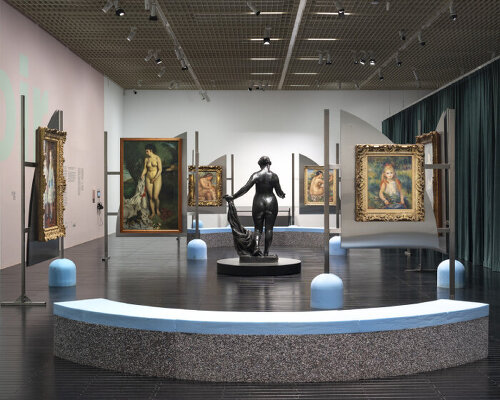juliana godoy completes exhibition design at masp’s renoir show
For decades, the Museu de Arte de São Paulo (MASP) teams — particularly the museology department — have been developing a proprietary system for mounting and handling artworks from a collection that extends far beyond the museum walls and circulates globally. This work has resulted in a unique fixation system, visible in the permanent exhibition Acervo em movimento, where artworks are displayed on the iconic glass easels conceived by Lina Bo Bardi in 1968. In these display elements, the transparency of the glass reveals how the paintings are supported. Each piece is framed within a hybrid structure: a wooden frame encases the perimeter of the artwork, while its back features a translucent polyethylene panel and a stainless steel bar with two holes. This allows for the attachment of a specially designed system of screws and bolts that secures the piece both to the glass easels and to traditional walls or panels.
For the inauguration of MASP’s new building in Brazil in 2025, Adriano Pedrosa and Regina Teixeira de Barros invited Juliana Godoy studio to develop the exhibition design for Cinco ensaios sobre o MASP – Renoir (Five Essays on MASP – Renoir), which features 13 works by the artist from the museum’s collection — each integrated into this unique mounting system. The curatorial desire was to create a custom display support for each painting, and it was in this dialogue with the museum’s past that the concept for the estrutura mole (soft structure) began to take form.
all images courtesy of Juliana Godoy
a contemporary counterpoint to lina bo bardi’s material clarity
Juliana Godoy’s studio knew that comparisons to the glass easels would be inevitable. After all, they were once again designing individual supports in a museum where Lina had established one of the world’s most iconic exhibition solutions. They were also engaging with the mounting mechanisms developed by Metro Arquitetos in 2015, when Pedrosa reintroduced the easels to the space they were never meant to leave. Their gesture, then, had to embody this legacy, acknowledging the beauty of a work that faces the viewer from one side, while revealing on the reverse the label and the very system that holds it in place. Thus, it was not just Lina’s easels that served as a reference, but the fixation system itself — so elegantly exposed in her design and present throughout the museum’s collection.
The soft structure emerges from this context: a freestanding object, entirely constructed from brushed stainless steel, composed of two curved, overlapping plates. Depending on the dimensions of the artworks, the structure discreetly reveals the back of each frame, establishing a visual and conceptual link with the museum’s museological practices. In 1987, Lina chose two materials — concrete and glass — to express material truth, a foundational concept in an era still shaped by the echoes of modernism.
Juliana Godoy reinterprets Lina Bo Bardi’s glass easels
Today, in 2025, one may not know precisely how to define the current moment, but it is undeniably the era of post-truth, where nothing is quite as it seems, and each person constructs their own narrative of reality. In this time, where logic and meaning often invert, a base that to some appears as solid blue concrete is, in fact, made of foam. Steel, though rigid, reflects and dissolves the surrounding colors into itself. Within this shifting field of perception, the estrutura mole stands — offering a silent rhetoric on form and materiality, honoring the museum’s legacy and collection, while subtly addressing the uncertainties of the time.
a new exhibition design for Cinco ensaios sobre o MASP – Renoir (Five Essays on MASP – Renoir)
the show features 13 works by the artist from the museum’s collection
developing the new estrutura mole (soft structure) model
the new structures are in dialogue with the museum’s past that the concept
the works are mounted on these freestanding objects
a base that to some appears as solid blue concrete is, in fact, made of foam
entirely constructed from brushed stainless steel, composed of two curved, overlapping plates
honoring the museum’s legacy and collection, while subtly addressing the uncertainties of the time
project info:
name: Five Essays about MASP – Renoir
designer: Juliana Godoy | @julianapgodoy
designboom has received this project from our DIY submissions feature, where we welcome our readers to submit their own work for publication. see more project submissions from our readers here.
edited by: ravail khan | designboom
The post juliana godoy reinterprets lina bo bardi’s glass easels with soft forms for MASP renoir show appeared first on designboom | architecture & design magazine.

